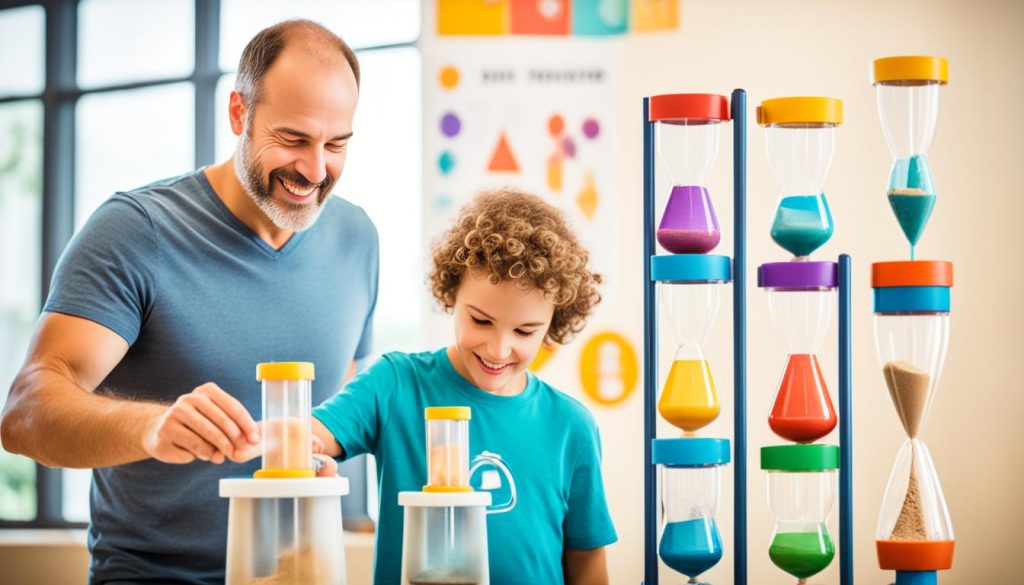Today, technology is a big part of our lives, changing how we talk, learn, and have fun. As parents, you have special challenges. How do you use technology without hurting your child’s growth? It’s not just about limiting screen time. It’s about making a safe space for your child to do well online and offline.
Do you remember when your child spent their days playing outside and using their imagination? Those days make us feel nostalgic but also worried. Now, it’s more important than ever to help your child feel good about themselves and talk openly with you. Too much screen time can harm sleep and make kids less active. But, you’re not facing these issues alone. With good plans and staying involved, you can use technology without hurting your child’s growth.
Key Takeaways
- Too much screen time can cause sleep problems and less physical activity.
- Kids are at risk online, facing cyberbullying and bad content.
- It’s key to balance online learning with traditional ways for full growth.
- Your tech habits affect how your child uses digital media.
- Teaching your child about being mindful and aware helps them use the internet safely.
- Teaching your child about online safety and privacy is vital today.
The Impact of Screen Time and Digital Overload
In today’s world, it’s vital to manage screen time for kids’ health. Too much screen time can lead to sleep issues, less physical activity, and trouble focusing. This is because smartphones, tablets, and computers are everywhere in kids’ lives.
Setting Clear Boundaries
It’s important to set limits on kids’ screen use. The American Academy of Pediatrics says kids under two shouldn’t watch screens. Kids two to four should have only one hour of screen time daily. Setting clear limits helps kids develop good habits and avoid too much screen time.

Encouraging Outdoor Activities
Encouraging kids to play outside can help reduce screen time’s negative effects. Being outside is good for their health and social skills. It also boosts creativity and lets kids explore nature. Sites like Khan Academy and YouTube channels from creators like Miss Rachel offer learning without screens.
Balancing Virtual and Real World
Finding a balance between screen time and real life is crucial for kids. Too much screen time can hurt their thinking skills, studies show. By mixing digital and real-world activities, parents can lessen these problems. Setting limits lets kids enjoy the world outside, promoting healthy growth.
- Too much screen time can harm kids’ thinking and growth.
- Parents can lessen these effects by setting clear rules.
- Outdoor play helps balance screen time, improving health and happiness.
- Using digital tools and active play boosts creativity and learning.
Ensuring Cybersecurity and Online Safety
In today’s world, keeping your kids safe online is crucial. With kids spending 3-4 hours a day playing games, they face many online dangers. Using parental controls and teaching them about privacy helps make the internet safer.

Implementing Parental Controls
Many parents don’t know what their kids do online, with 56% not checking often. Tools like Qustodio, Net Nanny, and Norton Family can block bad content and watch internet use. This lowers the risk of online dangers. Setting rules for online behavior teaches kids to use the internet responsibly.
Educating About Privacy
Only 29% of parents talk with their kids about online safety and privacy. It’s important to teach them about privacy settings on social media to avoid sharing too much. Teaching kids to manage their online presence and respect privacy settings helps them make safer choices.
Discussing Potential Dangers
Cyberbullying affects 42% of kids aged 10-17, and 72% of kids 8-17 have seen something they shouldn’t have. Talking about the dangers of the internet is key. It helps kids know how to deal with cyberbullies and stay safe online.
| Statistic | Percentage |
|---|---|
| Children aged 3-18 play online games | 91% |
| Parents not regularly monitoring their children’s online activities | 56% |
| Children aged 8-17 encountering inappropriate content online | 72% |
| Parents discussing online safety and cybersecurity with children | 29% |
| Parents not discussing privacy settings on social media | 67% |
| Children aged 10-17 experiencing cyberbullying | 42% |
| Parents unaware of all digital devices their children use | 75% |
Addressing Digital Addiction and Social Isolation
Digital addiction and social isolation are big worries for many parents today. With technology everywhere, kids might struggle to balance screen time with real social life. Talking well with their parents is key to solving these problems and helping kids have good habits.

Promoting Face-to-Face Social Interactions
It’s vital to get kids to interact face-to-face to fight social isolation. Activities that need people talking and working together help kids get better at social skills and feeling good. Things like sports, group activities, and joining clubs let kids meet others away from screens.
Planning Regular Family Outings
Going out as a family helps everyone take a break from screens and spend quality time together. Things like hiking, visiting museums, or playing games together make family bonds stronger and help parents and kids talk more. These outings help fight digital addiction and help kids grow independent by seeing different places and situations.
Modeling Positive Tech Habits
Parents should show good tech habits to influence their kids. This means setting rules for device use, not using screens during meals, and talking face-to-face. Showing these habits helps kids see that tech isn’t a replacement for real life. A balanced tech life can stop the bad effects of too much screen time, like feeling anxious or depressed.
Here is a look at how balanced tech habits and too much screen time affect us:
| Balanced Tech Habits | Excessive Screen Time |
|---|---|
| Enhanced social skills | Increased social isolation |
| Reduced anxiety and depression | Higher incidence of mental health issues |
| Improved cognitive functioning | Decreased learning capacity |
| Stronger family bonds | Weaker parent-child communication |
In conclusion, by encouraging face-to-face time, planning family activities, and showing good tech habits, parents can tackle digital addiction and social isolation. These steps make family ties stronger and help kids grow socially on their own in the real world.
Managing Media Influence and Body Image Issues
Today, 40% of kids aged 8 to 12 and 95% of teens aged 13 to 17 use social media. This use affects their body image and self-esteem a lot. Spending more than three hours a day on these platforms can make teens more likely to feel depressed and anxious.
About one in three girls aged 11 to 15 feel addicted to social media. And 46% of teens say social media makes them feel worse about their bodies. This shows why it’s key to manage media influence to help kids feel good about themselves.

Teaching Critical Media Literacy
It’s vital to teach kids to think critically about the media they watch or read. Parents can help them see how unrealistic many media images are. This helps reduce the bad effects of media on them.
Encouraging Discussions About Body Positivity
Talking openly about body positivity is important. Talking about different body types and real beauty can help kids. This makes them see their worth is more than just how they look.
Emphasizing Inner Qualities
Focus on what’s inside, not just how someone looks. Parents should talk about being kind, empathetic, and strong. This helps kids feel better about themselves and boosts their self-esteem.
| Aspect | Statistics |
|---|---|
| Children using social media (8-12 years) | 40% |
| Teens using social media (13-17 years) | 95% |
| Risk of depression & anxiety with over 3 hours of social media use | Double |
| Feel addicted to social media (girls 11-15) | 33% |
| Teens feel worse about their bodies due to social media | 46% |
Maintaining Personal Connection Amidst Digital Distraction
In today’s world, it’s hard to keep a personal connection in families because of all the digital gadgets. It’s key to focus on building a strong bond between parents and kids to fight these distractions. Studies show that 85% of parents think having a family plan for media use is vital. This plan helps balance time with and without devices, keeping the bond real.
Talking openly and regularly with your kids is crucial. About 92% of parents think it’s important to talk about what they do online. Also, 78% talk with their kids about their social media use. This helps close the gap in understanding.
Helping your child’s mental health is also key, especially since 45% of parents look for signs of too much media use. Setting times when no screens are allowed, like during meals or at bedtime, helps. This helps protect their mental health and well-being.
It’s not just about cutting down on screen time. It’s also about teaching Family Respect and Empathy. Creating areas or times without devices helps everyone connect better. This idea matches what the American Academy of Pediatrics suggests. They say kids under two should watch less TV to help them talk and socialize better.
| Activity | Contribution to Stronger Bonds |
|---|---|
| Family Media Plans | 85% of parents agree they help balance screen time |
| Regular Discussions | 92% of parents believe they foster better communication |
| Screen-Free Times | 67% implement this during meals or bedtime |
| Monitoring Online Experiences | 64% of parents actively monitor their children’s activity |
Encouraging kids to think about what they watch online and talking openly with them helps keep family bonds strong. Being involved in your child’s online life supports their mental health. It also makes the bond between you and your child stronger, building respect and empathy in your family.
Balancing Online Education and Traditional Learning
Parents face a big challenge in balancing Online Education with Traditional Learning today. Each method has its own strengths. When used together, they help kids learn for life and develop good habits.
Choosing High-Quality Educational Apps
Apps like Khan Academy and Duolingo can really boost Online Education. They offer lots of knowledge and make learning fun. It’s key to pick apps that are worth it, easy to use, and fit your child’s learning style.
Incorporating Offline Learning Experiences
Learning outside of screens is just as vital. Things like doing science experiments, reading books, and making art help with Traditional Learning. These activities also help kids stay active and cut down on screen time.
| Aspect | Online Education | Traditional Learning |
|---|---|---|
| Flexibility | High – study during children’s nap times, after bedtime | Fixed – specific school hours |
| Cost | Usually more affordable, with payment plans and bundled learning materials | Potentially higher, with separate textbook costs |
| Program Variety | Diverse range of programs and courses | Limited by geographical location |
| Social Interaction | Virtual through discussion forums and study groups | Face-to-face interactions with peers and teachers |
Mixing these methods can make learning better for your child. It combines the flexibility and wide range of Online Education with the structure and social benefits of Traditional Learning.
Setting Positive Tech Habits as a Parent
It’s key to set good tech habits as a parent. This sets the example you want your kids to follow. Studies show that 72% of parents help their kids use technology wisely by using it in a balanced way. This helps with Positive Parenting and supports kids’ growth outside of screens.
Avoiding Excessive Device Use
A good way to be a positive parent is to not use devices too much. About 45% of parents keep an eye on their screen time and cut back if it gets too high. This shows kids how to use tech wisely. Adding fun, healthy activities like drawing, fitness, and meditation shows what balanced tech use looks like.
Prioritizing Face-to-Face Interactions
Putting time aside for face-to-face talks is also key. Research shows 78% of parents cut down on screen time during meals to spend quality time together. These moments help kids open up and talk about tough stuff or deal with sibling issues. Having tech-free times helps build strong family bonds and emotional health.
Creating Tech-Free Zones
Having tech-free areas at home can really improve family time. 85% of parents think regular screen-free activities are important for a healthy life. You might choose certain rooms or times to be device-free. This encourages deep talks and supports kids learning the joy of being off-screen.
Promoting Mindfulness and Mental Well-being
Helping kids grow up in a world filled with digital devices is key. By teaching them self-awareness and stress-relief, parents can boost their mental health. This also encourages kids to find interests outside of screens.
Encouraging Self-Awareness in Children
Mindfulness is great for kids, helping them manage their feelings and make better choices. It teaches them to understand their emotions and actions. Kids who learn mindfulness are more patient, cooperative, and willing to share.
This helps them do well in life and at work.
Teaching Stress-Relief Techniques
It’s important to teach kids how to handle stress. Mindfulness practices like MBSR can reduce stress, anxiety, and panic in kids. These activities improve focus, empathy, and self-control.
Doing these activities every day can cut down on bad behavior and help kids do better in school.
Creating Tech-Free Times
Setting aside time without tech is key to mindfulness and letting kids discover new hobbies. Parents should show good tech habits by having screen-free times. Activities like reading, making art, and playing outside help kids find interests beyond screens.
| Benefits of Mindfulness | Impact Statistics |
|---|---|
| Increased Focus and Attention | 60% Improvement |
| Stress and Anxiety Reduction | 55% Decrease |
| Enhanced Emotional Regulation | 70% Improvement |
Practical Tips for Digital Age Parenting and Raising Kids
Parenting in the digital age means balancing tech’s good and bad sides. Kids aged 8 to 12 spend about six hours daily on screens. It’s key to set clear rules about screen time, as 65% of parents think their kids use devices too much.
Teaching kids the value of hard work is vital. Use time management apps to help them focus on homework and other activities. This builds responsibility and diligence. Apps like Kidzania and Greenlight can also teach kids about money and investing.
It’s important to be involved in your kids’ online lives. Only 40% of parents talk often with their kids about staying safe online, but 60% worry about it. Tools like Bark and Youth Digital help monitor and teach kids, keeping them safe online. Instagram has controls for parents to watch their kids’ social media.
Teaching kids good manners online is just as crucial as offline. Talk often about what’s right and wrong online. Make tech-free areas at home and plan device-free family time to set a good example.
At events like Screen Smart, experts stress the need for parents to get involved. Joining the Phone-Free Schools Movement helps set rules for device use. The “Nina’s Got Good News” Podcast and Jonathan Haidt’s “The Anxious Generation” offer more advice and strategies.
The Benefits of Digital Detox
In today’s world, gadgets are making people spend more time on screens. Taking a break from digital devices can make everyone feel better. It helps with mental health and makes families closer. By putting down our phones, we can focus on what’s important.
This includes helping kids grow and learn, making them more aware of themselves, and keeping family traditions alive.
Planning a Digital Detox Schedule
It’s key to plan a digital detox to see its benefits. Start by tracking how much time everyone spends on screens. You might be surprised by how much time is wasted on social media or watching shows.
Then, think of fun things to do without screens, like going for walks, playing games, or visiting museums. Doing this cuts down on screen time and brings families closer together.
Creating Tech-Free Zones
Having tech-free areas at home helps kids and families. Make dining and bedrooms screen-free for better conversations and sleep. Turn off notifications to focus on each other more.
This helps kids grow and keeps families connected through special traditions.
Engaging in Alternative Activities
Doing different things is key to fighting addiction to screens. Too much social media can make people feel anxious or lonely, especially teens. Activities like hiking, crafting, or going to events make quality time with family.
Reading books, listening to podcasts, or audiobooks are great for learning and storytelling. They help kids’ mental health and self-awareness.
For more tips on talking with kids, check out this resource.
Here’s a table showing how digital detox and screen time affect families:
| Aspect | Effect of Digital Detox | Consequence of Excessive Screen Time |
|---|---|---|
| Mental Health | Improved focus, reduced anxiety, and better emotional well-being | Increased anxiety, depression, and low self-esteem |
| Family Bonds | Strengthened through shared activities and meaningful conversations | Eroded by lack of interactions and shared experiences |
| Child Development | Enhanced self-awareness and nutritional habits | Potential negative impact on brain development and learning |
| Personal Skills | Improved interpersonal and communication skills | Impaired social skills due to limited face-to-face interactions |
Conclusion
Parenting today comes with both ups and downs. It’s key to set limits on screen time and encourage outdoor play. This helps balance the digital and real worlds. Teaching kids about online safety is also crucial for their well-being.
Dealing with digital addiction and social isolation is important. Encouraging face-to-face interactions and family outings helps fight these problems. By showing good tech habits, you set a good example for your kids.
It’s important to manage media’s impact and talk about body image. Teaching kids about media literacy is key for their mental health. This helps them feel good about themselves.
It’s important to balance online learning with traditional education. As a parent, setting good tech habits helps keep family bonds strong. Teaching mindfulness and mental well-being helps kids be emotionally strong and aware.
These strategies prepare kids for kindergarten and strengthen family bonds. They also help grow child creativity in a healthy way.
Studies show most parents focus on their kids’ emotional well-being and communication. Many value traditional values and religious teachings. Warm, supportive parenting helps prevent emotional and behavioral problems in kids.
By focusing on these practices, you help your child grow well in all areas. This ensures they have a strong support system for their mind and heart.
FAQ
How can you navigate the challenges of parenting in the digital age?
How can you set clear boundaries for screen time in your household?
What are some ways to protect children’s cybersecurity and online safety?
How can you address digital addiction and social isolation in children?
How can you manage the media’s influence on your child’s body image?
How can you maintain personal connections within your family amidst digital distractions?
How can you balance online education with traditional learning for your child?
What are some ways to set positive tech habits as a parent?
How can you promote mindfulness and mental well-being in a digital era?
What are some practical tips for parenting in the digital age?
What are the benefits of a digital detox for children?
This post contains affiliate links. If you click on a link and make a purchase, I may earn a small commission — at no extra cost to you. Thank you for supporting this blog and helping me keep the patterns free! Read the full Affiliate Disclosure & Transparency.
